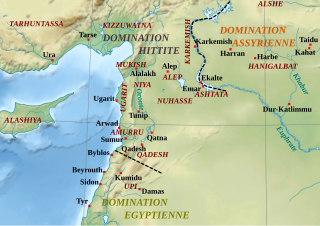
Arzawa was a region and political entity in Western Anatolia during the Late Bronze Age. In Hittite texts, the term is used to refer both to a particular kingdom and to a loose confederation of states. The chief Arzawan state, whose capital was at Apasa, is often referred to as Arzawa Minor or Arzawa Proper, while the other Arzawa lands included Mira, Hapalla, Wilusa, and the Seha River Land.

Šuppiluliuma I, also Suppiluliuma or Suppiluliumas was an ancient Hittite king.
Piyassili, also known as Sarri-Kusuh, was a Hittite prince and a middle son of King Šuppiluliuma I—younger than the heir Arnuwanda II, but older than the eventual successor Muršili II and probably older than the ill-fated Zannanza too. After Šuppiluliuma concluded a treaty with Shattiwaza, son of King Tushratta of Mitanni, and married one of his daughters to him, Piyassili led a Hittite army that put Shattiwaza on the throne of Hanigalbat. According to Hittite sources, Piyassili and Shattiwaza crossed the Euphrates at Carchemish, then marched against Irridu, already in Hurrian territory. After having reduced Irridu and Harran, they continued east towards to Washukanni and perhaps conquered the capital Taite as well.

Wilusa or Wilusiya was a Late Bronze Age city in western Anatolia known from references in fragmentary Hittite records. The city is notable for its identification with the archaeological site of Troy, and thus its potential connection to the legendary Trojan War.
Mursili II was a king of the Hittite Empire c. 1330–1295 BC or 1321–1295 BC.
Arnuwanda II was a Hittite great king who reigned in the late 14th century BC, perhaps in c. 1322–1321 BC. His reign was a briefly interlude between those of his father Šuppiluliuma I and younger brother Muršili II.
Tudḫaliya II was a Hittite great king in the late 15th/early 14th century BC, ruling in perhaps c. 1425–c. 1390 BC. He was the father-in-law and predecessor of Arnuwanda I.

Tudḫaliya III, with the additional Hurrian name Tašmi-Šarri, was a Hittite great king in Anatolia during the Late Bronze in the 14th century BC, in c. 1380–1350 BC. He was the son and successor of Arnuwanda I and the predecessor, father-in-law, and adoptive father of Šuppiluliuma I.
The Kaska were a loosely affiliated Bronze Age non-Indo-European tribal people, who spoke the unclassified Kaskian language and lived in mountainous East Pontic Anatolia, known from Hittite sources. They lived in the mountainous region between the core Hittite region in eastern Anatolia and the Black Sea, and are cited as the reason that the later Hittite Empire never extended northward to that area. They are sometimes identified with the Caucones known from Greek records.
The Manapa-Tarhunta letter is a fragmentary text in the Hittite language from the 13th century BC. The letter was sent to the Hittite king by Manapa-Tarhunta, client king of the Seha River Land. In the letter, Manapa-Tarhunta discusses Hittite attempts to reassert control over northwest Anatolia. The letter is particularly notable for its mention of Wilusa, generally identified with Troy.

The Tawagalawa letter is a fragmentary Hittite text from the mid 13th century BC. It is notable for providing a window into relations between Hittites and Greeks during the Late Bronze Age and for its mention of a prior disagreement concerning a city called Wilusa, generally identified with the archaeological site of Troy.
Piyama-Kurunta was a prince and regent for the last independent king of Arzawa, a Bronze Age kingdom of western Anatolia. The king of Arzawa Uhha-Ziti named his son "Gift of the god Kurunta", after a god whose name had featured in the names of previous Arzawan kings.
Uhha-Ziti was the last independent king of Arzawa, a Bronze Age kingdom of western Anatolia around 1320 BC.
The Milawata letter is an item of diplomatic correspondence from a Hittite king at Hattusa to a client king in western Anatolia around 1240 BC. It constitutes an important piece of evidence in the debate concerning the historicity of Homer's Iliad.
Piyamaradu was a warlord mentioned in Hittite documents from the middle and late 13th century BC. As an ally of the Ahhiyawa, he led or supported insurrections against the Hittite empire in Western Anatolia. His history is of particular interest since his area of activity may have included Wilusa, thus suggesting a potential connection to the myth of the Trojan War.

Nuhašše, was a region in northwestern Syria that flourished in the 2nd millennium BC. It was east of the Orontes River bordering Aleppo (northwest) and Qatna (south). It was a petty kingdom or federacy of principalities probably under a high king. Tell Khan Sheykhun has tenatively been identifed as kurnu-ḫa-šeki.

Hapalla, also written as Haballa, was a kingdom in central-western Anatolia during the Late Bronze Age. As one of the Arzawa states, it was a sometime vassal and sometime enemy of the Hittite Empire.

The Seha River Land was a kingdom in Western Anatolia in the Late Bronze Age known from Hittite texts. Part of Arzawa, it was located north of Mira and south of Wilusa, and at one point controlled the island of Lazpa.
Kaymakçı is a Bronze Age archaeological site overlooking Marmara Lake in Manisa Province, Turkey. Given its size and location, the settlement is considered a leading candidate for the capital city of the Seha River Land.
Kupanta-Kurunta was the first recorded king of Arzawa, in the early 14th century BC.





